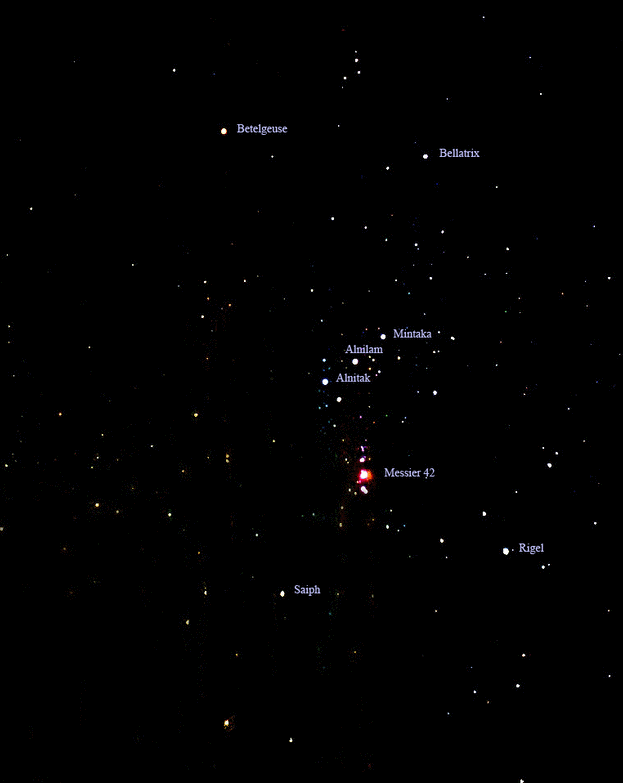
Without the atmosphere, the sun is set against the galactic center in this view to the south, midday, Thursday, December 21, 2023. Brilliant Venus is to the west along the ecliptic with Mars much closer to the sun and thus, lost in its glare at sunrise.
This Year’s Winter Solstice Occurs Today, Thursday, December 21, 2023 at 10:27 pm EST (3:27 UTC, December 22, 2023)
In the illustration above, the angular distance on the sky at the meridian between the Celestial Equator (the projection of the Earth’s equator onto the sky) and the Ecliptic (the plane of the Solar System) is exactly equal to the angular tilt of the Earth’s axis of rotation.
The sun is at its lowest point on the sky at midday during the third week in December in the Northern Hemisphere and represents the ‘beginning of winter’. The two Equinoxes (Vernal or ‘Spring’, 3rd week in March and Autumnal, 3rd week in September) occur when the sun crosses the Celestial Equator at the midpoint between these highest and lowest points of the sun’s apparent travel across the sky (the two solstices). The Celestial Equator represents the projection of the Earth’s equator on the sky. It should be noted that the Southern Hemisphere experiences the same seasons but at opposite times during the year. Summer in Australia occurs during December and January, while Winter occurs during June and July.
Brilliant Venus
If we could remove the earth’s atmosphere and look due south on the date of this year’s Winter Solstice, we would see Venus preceding the sun as a brilliant morning object. Mars is there too but is lost in the glare of the sun. Note how the planets are lined up, close to the ecliptic.
The Brightest Stars
Winter in the Northern Hemisphere has always been associated with some of the brightest stars in the sky. Indeed, some of the Myths surrounding the Star of Bethlehem and some Christmas Carols speak of these stars. Stars such as Sirius in Canis Major, the great dog, Rigel and Betelgeuse in Orion with his 3 belt stars are good examples.

Orion animated zoom, beginning first with the full constellation, then closer to the belt stars and then finally to the great nebula in Orion, Messier-42. Image courtesy, the author.

A view to the south at 8:30 PM, EST on the night of this year’s Winter Solstice. Canis Major with Sirius is rising to the southeast with Orion higher up, Jupiter and the waxing first-quarter moon is to the west with Aldebaran, the right eye of Taurus, the bull. Image via Stellarium.
The Angle of Insolation and the Shortest Day and Longest Night
Often referred to as the ‘beginning of winter‘, a generally subjective term, the Winter Solstice in the Northern Hemisphere is the day the sun is at its lowest point above the southern horizon at midday. In practical terms, this is the moment during the year when Northern Hemisphere inhabitants receive the least amount of energy from the sun. This angle above the horizon, known as the ‘Angle of Insolation‘, determines how much energy is received from the sun at a given location. It derives from the earth’s axial tilt of 23.5 degrees from the vertical. With the axis tilted and always pointing towards the same point on the sky, the energy from the sun each hemisphere receives changes during the year. The Winter Solstice also marks the calendar as the shortest day and, correspondingly, the longest night of the year.
Distance From the Sun
The earth’s distance from the sun does not play a major role in seasonal climatic change. The Earth is at its perigee during January and at its apogee during July. All orbits are elliptical with a closest point and most distant point; the closest point is the perigee or perihelion and the most distant point, the apogee or aphelion when it pertains to the sun. Aphelion actually occurs during July while perihelion occurs during January. So, clearly, with the sun farthest during the warmest months in the Northern Hemisphere and at its closest point during the coldest months, the distance to the sun plays a minimal role in seasonal climatic change.
December 25
It’s generally accepted that December 25th was not the day Jesus was born but the day that closely corresponded with the ancient Roman celebration of Saturnalia, the festival and holiday honoring the Roman god Saturn. All sanctions were lifted during this festival, permitting the Christians to likewise celebrate the birth of Christ, unbeknownst to the Romans. That this day also corresponds with the Winter Solstice is no coincidence. The Romans observed the sun’s elevation at midday slowly increase with each day after the winter solstice; the sun, the bringer of life and warmth, was returning and, thus, a cause for celebration.
It is also generally accepted that Jesus was born in the early Spring of 7 BC. Please see this article for all the details and full account of what ‘The Star of Bethlehem‘ actually was.
A quick, interactive web-based version of Stellarium is available here Tonight's Sky. When you launch the application, it defaults to north-facing and your location (on mobile and desktop).
Astronomy For Change: https://astronomyforchange.org
Did you enjoy this article or like what we do? Why not leave a tip or buy us a Coffee?
Follow Us On Twitter: https://twitter.com/astronomychange
Why not support us on Patreon: https://www.patreon.com/astronomyforchange
Imagination is more important than knowledge
![]()
An index of all articles can be found here.
If you enjoyed this article, please consider supporting us with a modest donation
or through a subscription on our Patreon Page
Membership at Astronomy for Change is Free!




